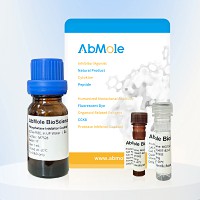All AbMole products are for research use only, cannot be used for human consumption.

The recombinant mouse HMGB1/Fc is a disulfide-linked homodimer. High-mobility group box 1 protein (HMGB1), also known as HMG-1 or amphoterin previously, is a member of the HMGB family.
HMGB1 is a DNA-binding nuclear protein, released actively following cytokine stimulation as well as passively during cell death. HMGB1 signals via the receptor for advanced glycation end-product (RAGE) and members of the toll-like receptor (TLR) family. The most prominent HMGB1 protein and mRNA expression arthritis are present in pannus regions, where synovial tissue invades articular cartilage and bone. HMGB1 promotes the activity of proteolytic enzymes, and osteoclasts need HMGB1 for functional maturation. As a non-histone nuclear protein, HMGB1 has a dual function. Inside the cell, HMGB1 binds DNA, regulating transcription, and determining chromosomal architecture. Outside the cell, HMGB1 can serve as an alarmin to activate the innate system and mediate a wide range of physiological and pathological responses.
However, extracellular HMGB1 also acts as a potent pro-inflammatory cytokine that contributes to the pathogenesis of diverse inflammatory and infectious disorders. HMGB1 has been successfully therapeutically targeted in multiple preclinical models of infectious and sterile diseases including arthritis.
Measure by its ability to induce TNF alpha in RAW264.7 cells, the ED50 for this effect is <15 ng/mL.
Accession: P63158
Apparent Molecular Weight: 25-35 KDa, under reducing condition
Endotoxin < 0.1 EU/µg
Lyophilized from a 0.2 μm filtered solution of PBS, pH 7.4.
| Form | Lyophilized powder |
| Solubility (25°C) | Reconstitute the lyophilized powder in distilled water up to 100 μg/ml. |
| Storage | Stored at ≤ -20°C, stable for one year after receipt. Reconstituted protein solution can be stored at 2-8°C for 2-7 days and at -20°C for 3 months. |
[4] Ben Lu, et al. Nature. Novel role of PKR in inflammasome activation and HMGB1 release
[5] A Tesniere, et al. Oncogene. Immunogenic death of colon cancer cells treated with oxaliplatin
| Related Other Proteins Products |
|---|
| Recombinant Human S100P (E. coli, N-6His)
Protein S100-P (S100P) belongs to the S100 family of Calcium-Binding Proteins. S100 proteins are localized in the cytoplasm and/or nucleus of a wide range of cells and it is involved in the regulation of a number of cellular processes such as cell cycle progression and differentiation. In addition to binding Ca, S100P also binds Zn and Mg, and may play a role in the etiology of prostate cancer. |
| Recombinant Human GSDMD Protein (E. coli, N-His)
GSDMD (Gasdermin D) is a protein that plays a crucial role in pyroptosis, a highly inflammatory form of cell death. It acts as a pore-forming protein, creating openings in the cell membrane and triggering the release of inflammatory molecules like interleukin-1β. |
| Recombinant Human TSPAN13 Protein (E. coli, C-His)
Recombinant Human TSPAN13 Protein expressed the target gene encoding Cys94-Glu164 with a polyhistidine tag at the C-terminus. |
| Recombinant Human SAA1 Protein (E. coli, N-6His)
Serum Amyloid A1 Protein (SAA1) is an acute phase apolipoprotein reactant that is produced predominantly by hepatocytes and is under the regulation of inflammatory cytokines. SAA may play a role in the immune system and facilitate the repair of injured tissues, it also acts as an antibacterial agent, and signals the migration of germ-fighting cells to sites of infection. |
| Recombinant Human IMPDH2 Protein (E. coli, N-His)
Recombinant Human IMPDH2 Protein (E. coli, N-His) expressed the target gene encoding Asp226-Phe514 with a His tag at the N-terminus. |
All AbMole products are for research use only, cannot be used for human consumption or veterinary use. We do not provide products or services to individuals. Please comply with the intended use and do not use AbMole products for any other purpose.


Products are for research use only. Not for human use. We do not sell to patients.
© Copyright 2010-2024 AbMole BioScience. All Rights Reserved.
